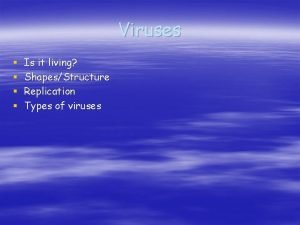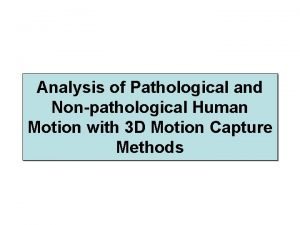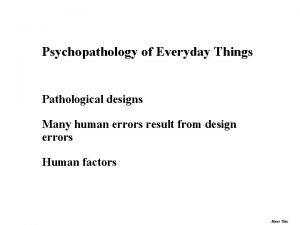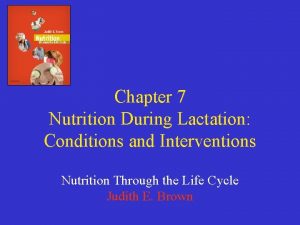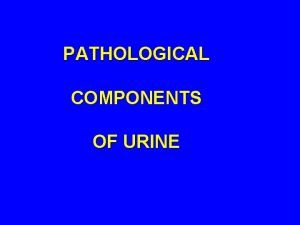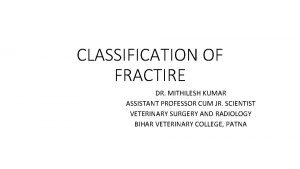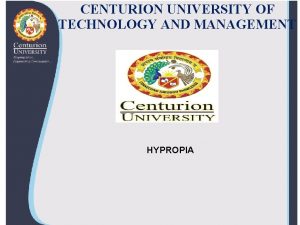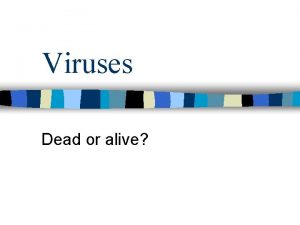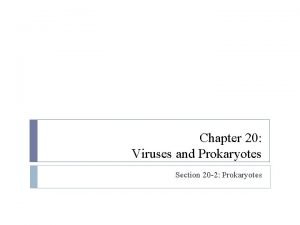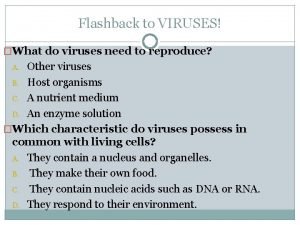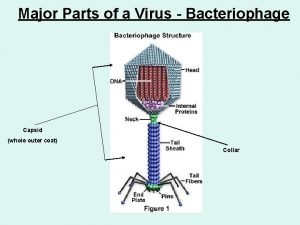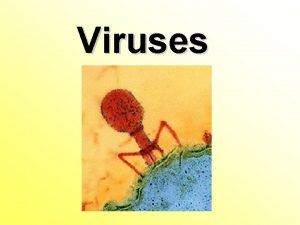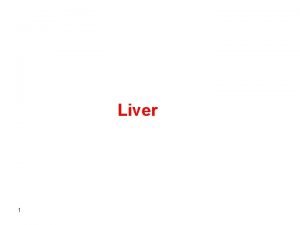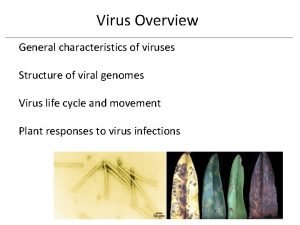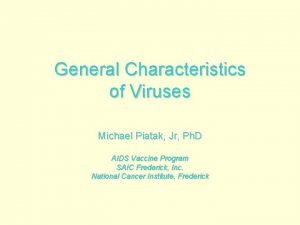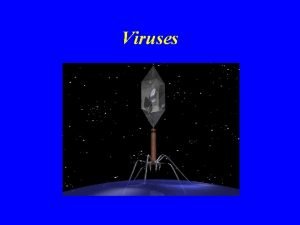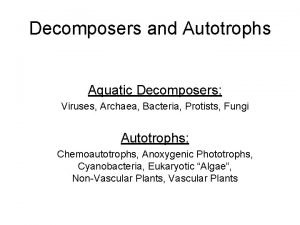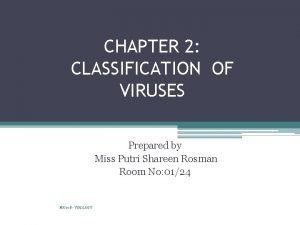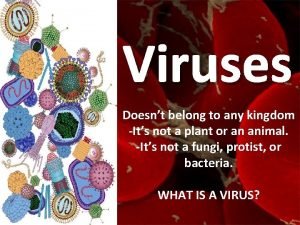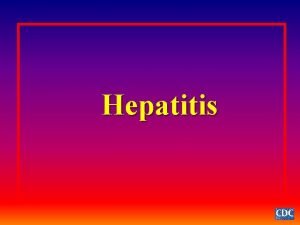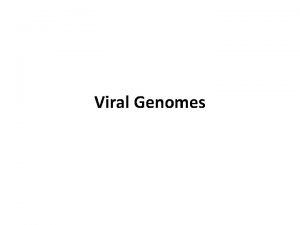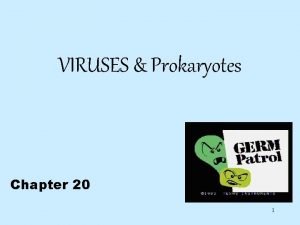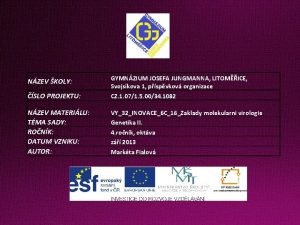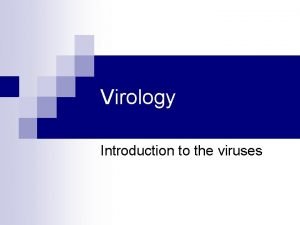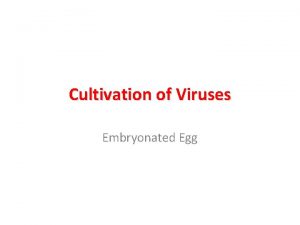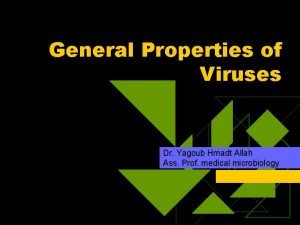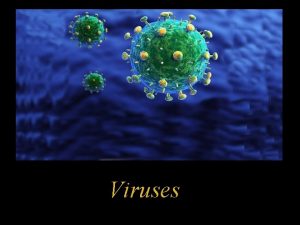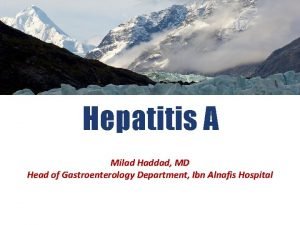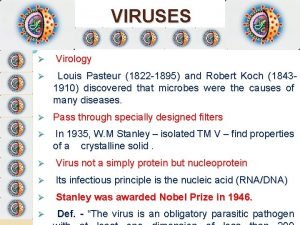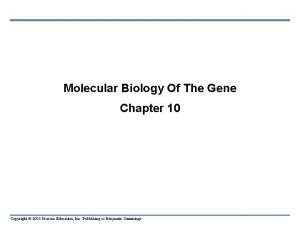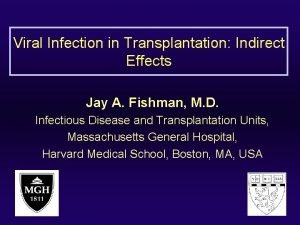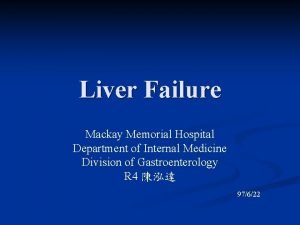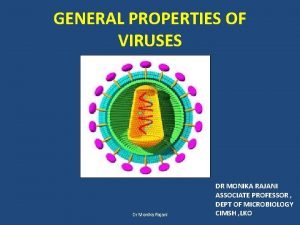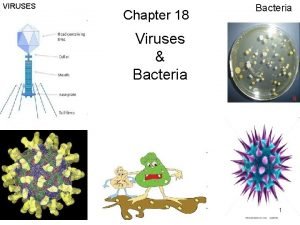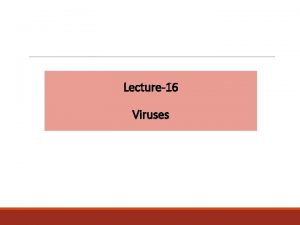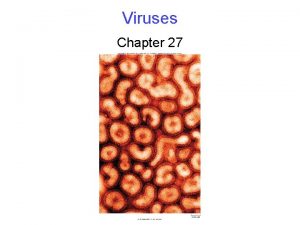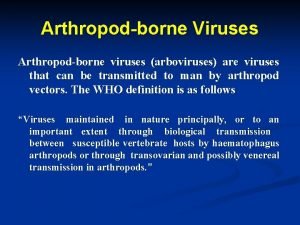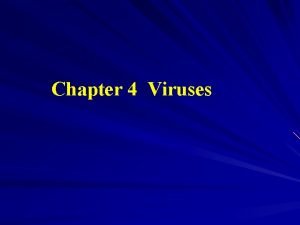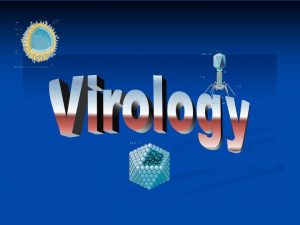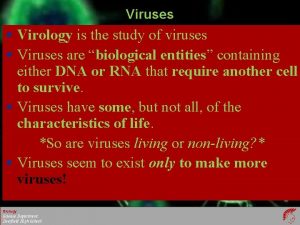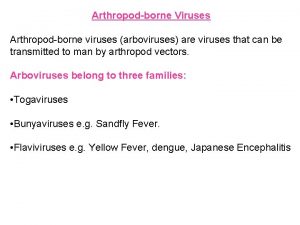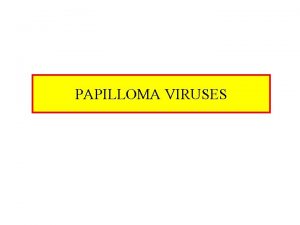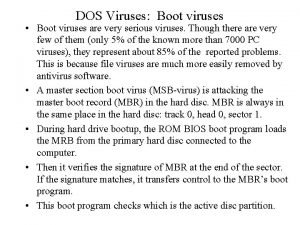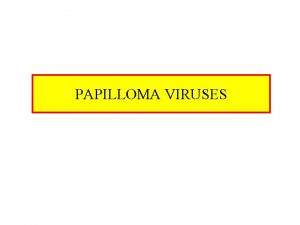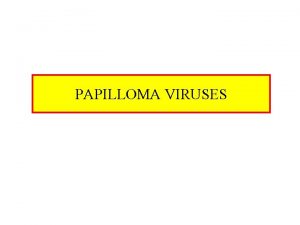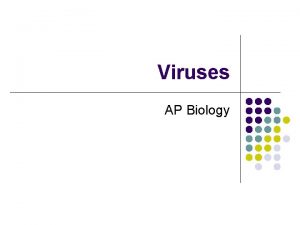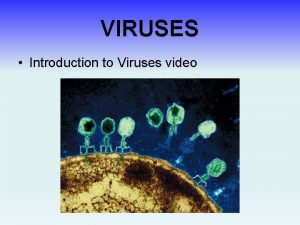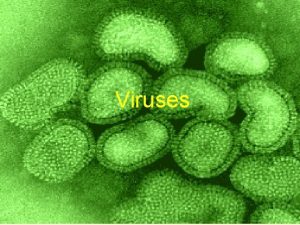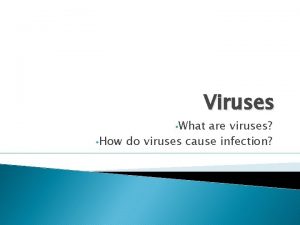Replication of Viruses q The pathological effects of





































































- Slides: 69

Replication of Viruses

q The pathological effects of the diseases caused by viruses result from the interplay of several factors: § Toxic effects of viral gene products on the metabolism of infected cells. § Reactions of the host to infected cells expressing viral genes § Modification of host gene expression by structural or functional interactions with the genetic material of the virus.

Host Range, Susceptibility, and Permissiveness § The process of infection begins with the coming together of a virus particle and a susceptible host cell. § The host range of a virus defines both the kinds of tissue cells and animal species that it can infect and in which it can multiply (wide Vs narrow). § Susceptibility defines the capacity of a cell or an animal to become infected.

Viral Replication: Basic Concepts ► Viruses are obligate intracellular parasites ► Viruses carry their genome (RNA or DNA) and sometimes functional proteins required for early steps in replication cycle ► Viruses depend on host cell machinery to complete replication cycle and must commandeer that machinery to successfully replicate

Viral Replication: Basic Concepts ► Replication cycle produces - Functional RNA’s and proteins - Genomic RNA or DNA and structural proteins ► Up to 100. 000 new particles are produced by each cycle - Referred to as burst size - Many are defective - End of ‘eclipse’ phase ► Replication may be cytolytic or non-cytolytic

Latent Period

q Viral replication is a complex process that involves multiple interactions at the molecular level. q Discussion will concentrate on aspects relevant to understanding of viral pathogenesis at the molecular level. q Important in the area of antiviral chemotherapy where it is needed to determine what stages are likely to be potential targets or susceptible to chemotherapeutic agents.

§ To infect a cell, the virion must attach to the cell surface, penetrate the cell, and become sufficiently uncoated to make its genome accessible to viral or host machinery for transcription or translation. § The cell acts as a factory providing the substrates, energy, and machinery necessary for synthesis of viral proteins and replication of the genome. § Each infected cell may produce as many as 105 particles(burst size), only 1 -10% of which are infectious

Types of Infection ► Productive ► Abortive of a cell may be: - (permissive). (non-permissive, defective). ► Stringent or restrictive(transient permissiveness). ► Transforming.

► Virus replication can be divided into eight stages, namely: Attachment, penetration, uncoating, genome replication, gene expression, assembly, maturation and release. ► These are purely arbitrary divisions, used here for convenience in explaining the replication cycle of a non- existing “ typical “ virus. ► Not all stages described here are detectable as distinct stages for all viruses, often they “blur” together and appear to occur almost simultaneously.

q These stages can be divided into three phases: I – Initiation phase -Attachment -Penetration -Uncoating II - Replication phase -DNA Synthesis -RNA Synthesis -Protein synthesis III - Release phase -Assembly -Maturation -Exit from cell

Steps in Viral Replication: Attachment ► First Step ► Surface protein on virus attaches to specific receptor(s) on cell surface - May be specialized proteins with limited tissue distribution or more widely distributed - Virus specific receptor is necessary but not sufficient for viruses to infect cells and complete replicative cycle

§ Attachment constitutes the specific binding of a viral protein VAP to a constituent of the cell surface (receptor/ anti-receptor). § Complex viruses may have more than one species of antireceptor molecules. § Anti-receptor molecules may have several domains, each of which may react with a different receptor. § Mutations in the genes specifying anti-receptors may cause loss of the capacity to interact with certain receptors.

§ Receptors identified thus far are largely glycoproteins or glycolipids. § Repulsion between virus and cell membrane impedes attachment because both are negatively charged. § Attachment, therefore, requires ions to reduce electrostatic repulsion, but it is largely independent of temperature and energy. § Attachment results from random collision between virions and cell surface at a frequency of 10 -3 to 10 -4 leading to a physical complementary union.

§ Early binding is reversible and firm binding requires specific receptor antireceptor interaction. § The susceptibility of a cell is limited by the availability of appropriate receptors, and not all cells in an otherwise susceptible organism express receptors. § Attachment of viruses to cells in many instances leads to irreversible changes in the structure of the virion.

§ In some instances, however, when penetration does not ensue, the virus can detach and elute from cell surface. § Some viruses have specific mechanisms for detachment (neuraminidase). § Elution leads to changes in the virus VAP which decrease or eliminate the possibility of subsequent attachment to other cells.

Penetration ►Second Step ►An energy dependent step that occurs almost instantaneously after attachment and it involves one of three mechanisms: ►Endocytosis (viriopexis ) of the virus particle resulting in accumulation of virus particles inside cytoplasmic vesicles. Most common. ►Fusion of the virion envelope with the cellular membrane (Requires fusion protein in viral envelope)

►Translocation of the entire virus across the plasma membrane. Rare and poorly understood. ►Penetration may be p. H independent and it is usually immediately followed (inseparable) by uncoating.

Penetration - Endocytosis q Most commonly, viruses enter cells by endocytosis (engulfment by the invagination of a section of plasma membrane). q Virus particles accumulate in cytoplasmic vesicles and are subsequenty uncoated.

Endocytosis of Non-enveloped RNA Viruses ► p. H dependent - Cell Receptor (Ig. G super family) - At low p. H, virus becomes lipophilic and forms a pore in the cell membrane - RNA genome is then ejected through the hydrophobic pore ► Can be inhibited by use of weak bases such as ammonium chloride & chloroquine

Endocytosis of Enveloped RNA Viruses q Influenza Virus as an example q Endosome is acidic (p. H 5 -6) q Exposed hydrophobic fusion domain q Differ from nonenveloped viruses in that their envelopes fuse with the membranes of the endosomes

Penetration - Fusion ► Direct FUSION of the virion envelope with the surface membrane of the cells may also take place with some viruses ► Virion envelope glycoproteins with fusion activity mediate the melding of the two phospholipids bilayers and mixing of the aqueous compartments previously separated by them. ► In some viruses a specialized glycoprotein is responsible for fusion (eg gp 41 of HIV)

Penetration - Translocation ► Translocation – Some non-enveloped viruses enter by translocation of the whole virus particle across the cell membrane. ► They ► It are then uncoated in the cytoplasm. is not understood how intact virus particles move directly through cell membranes

Steps in Viral Replication: Uncoating ► Third Step ► Makes viral nucleic acid available for transcription to permit multiplication to proceed ► Mechanism variably understood depending upon the virus

► Uncoating usually occurs after penetration. ► Capsid is removed and genome is exposed usually as a nucleoprotein complex ► Process is poorly understood and variable ► In reoviruses, the capsid only ever partially disintegrates and replication takes place in a structured particle. ► In poxviruses, host factors induce the disruption of the virus.

Uncoating ► The release of DNA from the core depends upon viral factors made after entry. ► Orthomyxo, paramyxo and picornavirus all lose the protective envelope or capsid upon entry into the cytoplasm. ► In the influenza virus, the M 2 envelope viral protein allow endosomal protons into the virion particle resulting in its partial dissolution. ► In herpesviruses, adenoviruses and papovaviruses, the capsid is eventually routed along the cytoskeleton to nuclear membrane

Expression and Replication of viral Genomes ►DNA Viruses § All DNA viruses, except poxviruses, replicate in the nucleus. § They utilize cellular RNA polymerase (DNA – dependent RNA Polymerase) for transcription. § Simple DNA viruses (Parvo and Papovaviruses) utilize host cell DNA – dependent DNA polymerase, whereas the larger more complex ones ( adeno, herpes, and poxviruses) encode their own DNA polymerases.

§ Viral polymerases are faster but less precise than cell polymerase causing a higher mutation rate and providing a target for antiviral drugs. § The fidelity of DNA replication is such that only one mistake is made in 109 – 1010 base pair replications compared with one in 103 -104 for RNA viruses. § Error – free replication arises from the ability of DNA polymerase to proof-read the DNA which they have just synthesized. § In contrast, RNA polymerases need not be self- correcting in as much as relatively high error rates can be tolerated.

§ In a few instances it is cellular enzymes that replicate the viral genome assisted by viral proteins (parvovirus). § In most cases the opposite is true, viral enzymes are responsible for genome replication although they utilize cellular proteins to aid this. § All DNA viruses known to infect vertebrates contain a monopartite genome.

►RNA Viruses § Most RNA viruses replicate in the cytoplasm using their own transcriptase, exceptions to this being influenza and retroviruses, part of the replicative cycle of which take place in the nucleus. § Virion - associated RNA polymerases have the activities of RNA polymerase, 5' capping, and 3' polyadenylation. § Host cells cannot replicate nucleic acid in the cytoplasm, so viruses that replicate in the cytoplasm carry all enzymes necessary for their replication and this applies to poxviruses and most RNA viruses.

§ Replication and transcription of RNA viruses are similar processes as the template is RNA in both cases, and ds RNA intermediates are formed. § Since RNA is degraded relatively quickly, the RNA polymerase must be provided or synthesized soon after uncoating to generate more viral RNA, or the infection is aborted.

§ The genomes of ss. RNA viruses are either: - Monopartite ( picorna, toga, paramyxo, rhabdo, corona, and retroviruses) or - Multipartite ( orthomyxo, arena, and bunyaviruses). § Most RNA genomes are linear

►DNA and RNA Viruses § The virus must be able to interact with the cell biosynthetic machinery according to the biochemical rules of the cell. § Transcription and hence translation usually proceed in two phases, early and late. - The early phase results in the synthesis of regulatory proteins and enzymes necessary for replication of viral nucleic acid. - The late phase leads to the synthesis of structural proteins which are usually made in excess.

§ Transcription of the viral genes is regulated by the interaction of specific DNA – binding proteins with promoter and enhancer elements in the viral genome. § Cells from different tissues or species express different DNA- binding proteins. § Different DNA and RNA viruses control the duration, sequence and quantity of viral gene expression and protein synthesis in different ways. § The more complex viruses encode their own transcriptional activators.

§ Translation proceeds in essentially the same fashion as eukaryotic m. RNA utilizing cellular t. RNA and initiation factors. § Posttranslational modification takes place utilizing cellular pathways. § Structural proteins of the virus may act as repressors of transcription by binding to viral DNA or RNA.

§ Viruses employ different tactics to promote the preferential translation of their viral m. RNA: - - In many cases, the concentration of viral m. RNA in the cell is so large that it occupies most of the ribosomes. - Block the egress of cellular m. RNA from the nucleus. - Inhibit cellular macromolecular synthesis and induce degradation of the cell’s DNA and m. RNA. - Increase the permeability of the cell membranes which decreases the ribosomal affinity for cellular m. RNA.

Expression and Replication of viral Genomes I- RNA Viruses 1 - Positive (+) strand RNA viruses coding for one Genome – sized m. RNA (polio, Flavi, HCV) ► Their coding domains are translated in their entirety. ► The product of translation, the polyprotein, is then cleaved. ► Synthesis of complementary full- length (-) strand RNA. ► The (-) strand RNA in turn serves as a template to make more(+) strand RNAs.

Flow of events during the replication of Picornaviruses

2 - Positive (+) Strand RNA viruses coding for one or more subgenomic m. RNAs (Toga, corona, calici, HEV) ► Only a portion (the 5' end) of the genomic RNA is available for translation in the first round of protein synthesis. ► A (-) strand is then synthesized, and this RNA in turn serves as a template for two size classes of (+) RNA molecules. ► Cleavage clearly involves virus- specified proteases, and the polyprotein itself is enzymatically active in Trans. ► Two or more subgenomic m. RNA species are made in cells infected with corona, calici or HE viruses.

Flow of events during the replication of Togaviruses.

►Central to the replication of (+) strand viruses is the capability of the genomic RNA to serve as m. RNA after infection. ►The consequences are two fold: ► First, enzymes responsible for the replication of the genome are made after infection ► Second, because all (+) strand genomes are monopartite, the initial products of translation of both genomic RNA and m. RNA species are necessarily a single protein.

3 - Retroviruses ► First step in replication is synthesis of a DNA strand complementary to the RNA genome, followed by digestion of RNA by a nuclease (ribonuclease H in the virion), and finally synthesis of a complementary DNA strand. ► The linear ds DNA translocated into the nucleus integrates into the host genome (Provirus). ► The products of transcription are genome-length RNA molecules (efficiently packaged into virions), and shorter, spliced m. RNAs that are translated to yield polyproteins that are processed by cleavage to individual viral proteins.

Flow of events during the replication of retroviruses.

4 - Non segmented Negative (-) strand RNA viruses ► They have their transcriptases packaged in the virion. ► The transcription of the viral genome is the first event after entry into cells (multiple functional m. RNAs are produced). ► Replication begins under the direction of newly synthesized viral proteins, a full-length(+) strand is made and serves as a template for the synthesis of (-) strand genomic RNA

5 - Segmented Negative strand RNA viruses ► The first step involves the synthesis of m. RNAs from each segment of the genomic RNA. ► The m. RNAs of influenza virus have heterogeneous nonviral 5’ end sequences (8 – 18 nucleotides ) that are stolen” from the host cell m. RNA molecules by viral proteins. ► The newly synthesized viral proteins replicate the genomic RNA segments to yield precise (+) strand copies of the virion RNAs ► A unique characteristic of them is reassortment of their genes in cells infected by more than one virion of the same group introducing new genotypes.

Flow of events during the replication of Orthomyxoviruses and Paramyxoviruses.

►The genes of (-) strand viruses serves as template for transcription only. ►The consequences are three- fold-: ► First, the virus must bring into the infected cell the transcriptase to make its m. RNAs. ► Second, naked RNA extracted from virions is not infectious. ► Third, m. RNAs produced are gene unit length, they specify a single polypeptide. ►Consequently, the (+) transcript which functions as m. RNA is different form the (+) strand RNA which serves as the template for progeny virus even though both are synthesized on the genomic RNA.

6 - Ambisenes RNA Viruses (Arenaviruses and Bunyaviruses) ► The expression of this information takes place in two stages. ► The genomic RNA is transcribed to yield (+) strand subgenomic size m. RNA. ► The appropriate full size complementary RNA is then transcribed to yield subgenomic size m. RNA. ► Because the replicative cycles begin with the transcription of genomic RNA, the ambisense viruses must carry their own polymerase into the infected cell.

7 - Double Stranded RNA viurses ► The multipartite reovirus genome is transcribed within the partially opened capsid by a polymerase packaged into the virion ► The 10 m. RNA (+) strand species are extruded from the exposed vertices of the capsid. ► The m. RNA molecules have two functions: ► first, they are translated as monocistronic messages to yield the viral proteins. ► Second, one RNA of each of the 10 species assemble within a precursor of particle in which it servers as a template for synthesis of the complementary strand, yielding ds genome segments.

Flow of events during the replication of Reoviruses

►II- DNA Viruses 1 - Double – Stranded DNA Viruses that Replicate in the Nucleus ► Significant differences exist in the replication strategies of Nuclear viruses. ► Papovaviruses encode a single protein that binds in close proximity to the origin of viral DNA synthesis, stimulates the cellular polymerase complex to replicate the viral DNA, and acts as a helicase. ► Adenoviruses encode a DNA polymerase but depend on the host cells for all other functions involved in the synthesis of their DNA. ► At The other extreme are the herpesviruses; HSV encodes numerous proteins involved in the pathway of the synthesis of DNA.

Flow of events during the replication of herpesviruses (herpes simplex viruses).

2 - Double stranded DNA Viruses that replicate in the cytoplasm ► Transcriptional events and most of the other events in the reproductive cycle seem to take place in the cytoplasm. ► Poxviurses have evolved all of the factors necessary for transcription and replication of their genome. ► Because host transcriptional factors are not involved, the cis - acting sites for the synthesis and processing of the m. RNA have diverged from those of the host. ► The initial transcription occurs in the core of the virion, the protein products of these transcripts function to release the viral genome from the core.

3 - Single- stranded DNA viruses (Parvoviruses) ► Multiplication requires the synthesis of a DNA strand complementary to the ss gnomic DNA in the nucleus and transcription of the genome. ► The B 19 virus replicates in mitotically active cells and prefers cells of the erythroid lineage. ► Factors available only during the S phase of the cell’s growth cycle and cellular DNA polymerase are required to generate a complementary DNA strand. ► A ds DNA version of the virion genome is required for transcription and replication.

► Inverted repeat sequences of DNA at both ends of the genome facilitate viral DNA synthesis. It forms a ds molecule in the form of hairpin loops. ► The palindromic sequence (about 115 bases at both ends) can fold back on it self and forms ds sequences stabilized by hydrogen bonding in the form of hairpin Y or T shape. ► The ds DNA replicative intermediate is transcribed by cellular RNA polymerases and replicated by DNA polymerase. ► In the absence of a helper virus, the genomes of dependent parvovirus appear to integrate into a specific locus on a human chromosome

Flow of events during the replication of Parvoviruses

4 - Hepadnaviruses ► Hepadnaviruses have a circular partially ds DNA genome. They replicate in the nucleus. ► The gap in the DNA of the virus is repaired first by a DNA polymerase packaged into virion. ► the genome is then transcribed into two classes of RNA molecules; RNAs specifying proteins and a full length RNA that serves as a template for the synthesis of genomic DNA by a virally encoded reverse transcriptase.

Flow of events during the replication of Hepadnaviruses (hepatitis B virus).

Assembly, Maturation, and Egress of viruses from infected cells ► Assembly of DNA viruses, except poxviruses, occurs in the nucleus and requires transport of the virion proteins into the nucleus. ► Assembly of pox and RNA viruses takes place in the cytoplasm. ► The assembly process begins when the concentration of structural proteins in the cell is sufficient to thermodynamically drive the process, much like a crystallization reaction.

► Structural proteins of simple icosahedral viruses can aggregate spontaneously to from structural units, which in turn assemble into empty capsids (procasids). ► Somehow, the viral nucleic acid now enters this structure via a mechanism that seems to involve a nucleotide sequence known as the “packing sequence”. ► Helical viruses assemble by adding blocks during coiling of the viral nucleic acid.

► Maturation and release are determined in part by site of replication and the presence of an envelope. ► Acquisition of an envelope occurs after association of the nucleocapsid with regions of host cell membrane modified by matrix protein and glycoproteins. ► Matrix proteins line and promote the adhesion of nuclecocapsids with the modified membrane. ► As more interactions occur, the membrane surrounds the nucleocapsid and the virus buds from the membrane.

strategies for maturation ► Three fundamental strategies for maturation have been described: - I- Intracellular assembly and Maturation - Nonenveloped viruses cause disintegration of the infected cell for their egress. II- Strategy of enveloped viruses -The last step in assembly of (-) strand RNA viruses is linked with their egress from infected cells by budding from the cytoplasmic or other membranes.

► Viruses that mature and egress by budding vary considerably in their effects on host cell metabolism and integrity. ► They range from highly cytolytic (toga, paramyxo) to viruses which are frequently noncytolytic (retroviruses). ► By virtue of the viral glycoprotein insertion into the cell surface, however, these viruses import upon the cell a new antigenic specificity and the infected cell can and does become a target for the immune mechanisms of the host.

III- Strategy for Herpesviruses - They assemble their nucleocapsid in the nucleus. - Envelopment and maturation occur at the inner lamella of the nuclear membrane - Herpesvirurses are cytolytic and invariably destroy the cell in which they multiply. - They also import new antigens on the infected cell.

Glycosylation and Budding ► In the glycosylation of their proteins, viruses use existing pathways. ► This involves a “signal sequence“ of 15 -30 hydrophobic amino acids that facilitate binding to a receptor on the cytoplasmic side of the RER. ► It then passes through the lipid bilayer to the luminal side where the signal sequences is removed by a signal peptidase allowing the addition of oligosaccharides.

► Glucose is then removed by glucosidase (trimming). ► The viral glycoprotein is then transported to the Golgi apparatus probably inside a coated vesicle, where the core carbohydrate is further modified and acylated (addition of fatty acids). ► Another coated vesicle now transports the acylated glycoprotein to the plasma membrane or cytoplasmic structures, probably with the help of a leading sequence that finds the destination (postal address or zip code. )

► Envelope glycoproteins are then cleaved into 2 polypeptide chains that remain covalently bound by S-S bonds. ► Then the hydrophilic N-terminus of the glycoprotein finds itself projecting from the external surface of the membrane while the hydrophobic domain near the cterminus remains anchored in the lipid bilayer. ► Budding is a form of exocytosis (reversed endocytosis) and viruses remain cell- associated for few hours and large numbers of viruses are released in consecutive waves.

Variability in viral Genomes and viral Multiplication ► On passage, viruses tend to yield defective mutants. ► It is convenient to classify defective viruses into two groups. §Viruses in the first group lack one or more essential genes and therefore are incapable of independent replication without a helper virus. - They can transform infected cells or transactivate oncogenic viruses in causing the cell to become malignant.

§ The second group comprises viruses which contain mutations and deletions and therefore cannot replicate in an efficient fashion. - Chronic debilitating infections of the CNS might in some fashion be related to viruses that are sluggish in their replication, in their ability to destroy the infected cells, or in their ability to alter the infected cell sufficiently to make it a target for the immune system of the host. . - Genetically, engineered viruses lacking one or several genes and which might be classified as defective may ultimately be viruses greatest gift to mankind; the means for the introduction of genes to complement genetic deficits or to selectively destroy cancer cells.
 Unlike lytic viruses, lysogenic viruses do not
Unlike lytic viruses, lysogenic viruses do not Lysogenic cycle animation
Lysogenic cycle animation Replication of viruses
Replication of viruses Bioflix activity dna replication nucleotide pairing
Bioflix activity dna replication nucleotide pairing Pathological analysis
Pathological analysis Pathological generals in repertory
Pathological generals in repertory Pathological designs
Pathological designs Pathological design
Pathological design Pathological prisoner syndrome
Pathological prisoner syndrome Pathologic jaundice
Pathologic jaundice Pathological condition
Pathological condition Pathological design
Pathological design Physical composition of urine
Physical composition of urine Biomedical waste introduction
Biomedical waste introduction Avulsion fractire
Avulsion fractire Absolute hypermetropia
Absolute hypermetropia Jaundice grading in adults
Jaundice grading in adults Pathological demand avoidance test
Pathological demand avoidance test Are viruses dead or alive
Are viruses dead or alive Computer viruses presentation
Computer viruses presentation Chapter 20 viruses and prokaryotes
Chapter 20 viruses and prokaryotes What are viruses lesson 3 answer key
What are viruses lesson 3 answer key Lytic infection
Lytic infection Lysogenic viruses do not
Lysogenic viruses do not Parts of a virus
Parts of a virus Importance of viruses
Importance of viruses Best viruses
Best viruses Hepatotropic viruses
Hepatotropic viruses Chapter 21 viruses and bacteria
Chapter 21 viruses and bacteria Which of the following is plant virus
Which of the following is plant virus Charateristics of viruses
Charateristics of viruses General properties of viruses
General properties of viruses Aquatic decomposers
Aquatic decomposers Nomenclature of viruses
Nomenclature of viruses General characters of viruses
General characters of viruses Section 19-3 diseases caused by bacteria and viruses
Section 19-3 diseases caused by bacteria and viruses Baltimore classification of virus
Baltimore classification of virus What does dna have that rna doesnt
What does dna have that rna doesnt Viruses video
Viruses video Hepatotropic viruses
Hepatotropic viruses Nonliving particle that replicates inside a living cell
Nonliving particle that replicates inside a living cell Are viruses alive yes or no
Are viruses alive yes or no General characteristics of viruses
General characteristics of viruses Section 1 studying viruses and prokaryotes
Section 1 studying viruses and prokaryotes Virus
Virus Chapter 18 section 1 bacteria
Chapter 18 section 1 bacteria Helical virus
Helical virus Cultivation of viruses
Cultivation of viruses Hmadt
Hmadt Spherical virus
Spherical virus Smallest infectious agent
Smallest infectious agent Hepatotropic viruses
Hepatotropic viruses Blood borne viruses
Blood borne viruses General characters of viruses
General characters of viruses Viruses
Viruses How active viruses multiply
How active viruses multiply Molecular biology of the gene chapter 10
Molecular biology of the gene chapter 10 How do viruses differ from living things
How do viruses differ from living things Cmv
Cmv Mackay memorial hospital
Mackay memorial hospital Egg inoculation diagram
Egg inoculation diagram Basic properties of viruses
Basic properties of viruses Why are viruses considered nonliving?
Why are viruses considered nonliving? Tư thế worm breton là gì
Tư thế worm breton là gì ưu thế lai là gì
ưu thế lai là gì Thẻ vin
Thẻ vin Tư thế ngồi viết
Tư thế ngồi viết Cái miệng xinh xinh thế chỉ nói điều hay thôi
Cái miệng xinh xinh thế chỉ nói điều hay thôi Các châu lục và đại dương trên thế giới
Các châu lục và đại dương trên thế giới Mật thư anh em như thể tay chân
Mật thư anh em như thể tay chân


